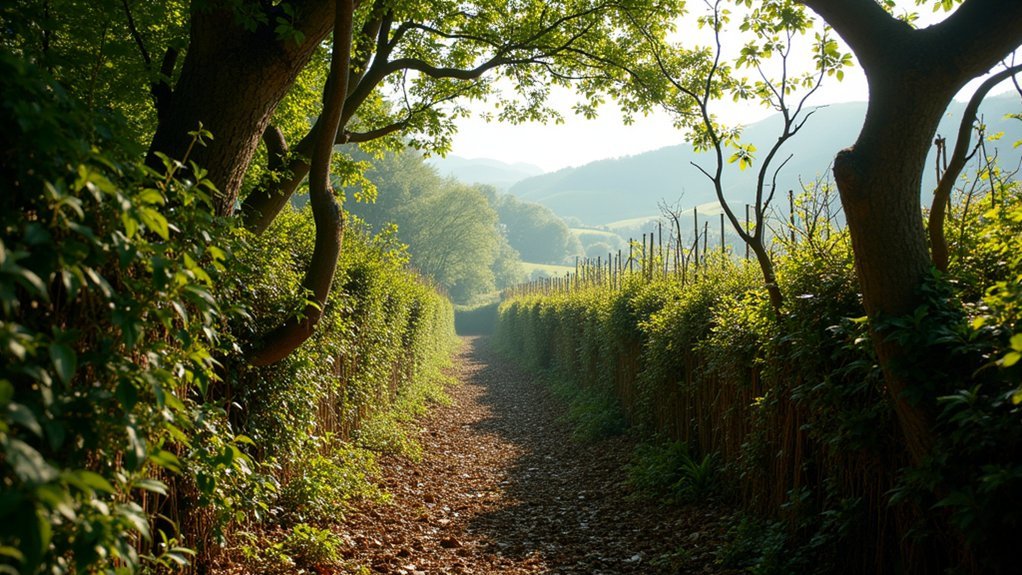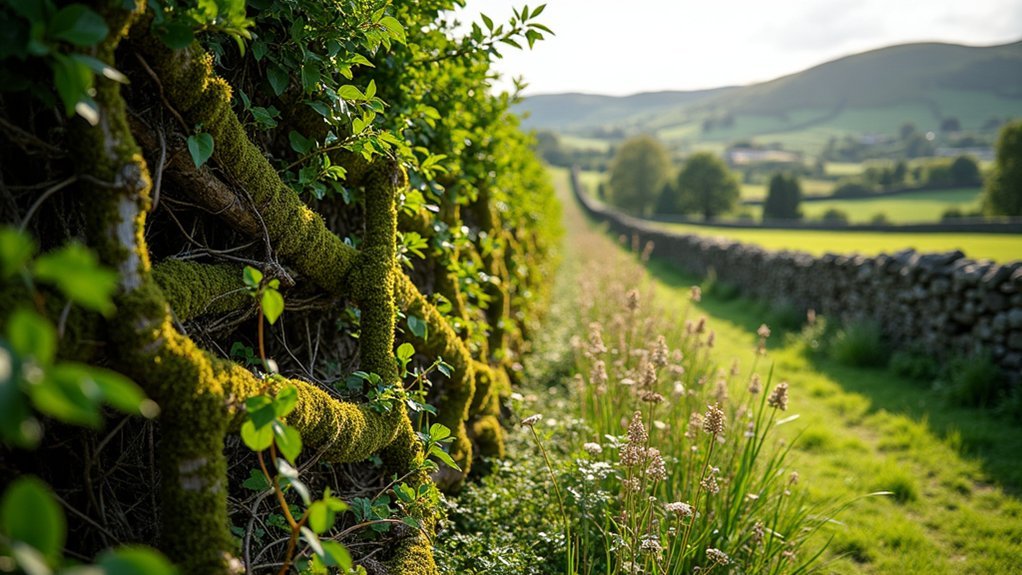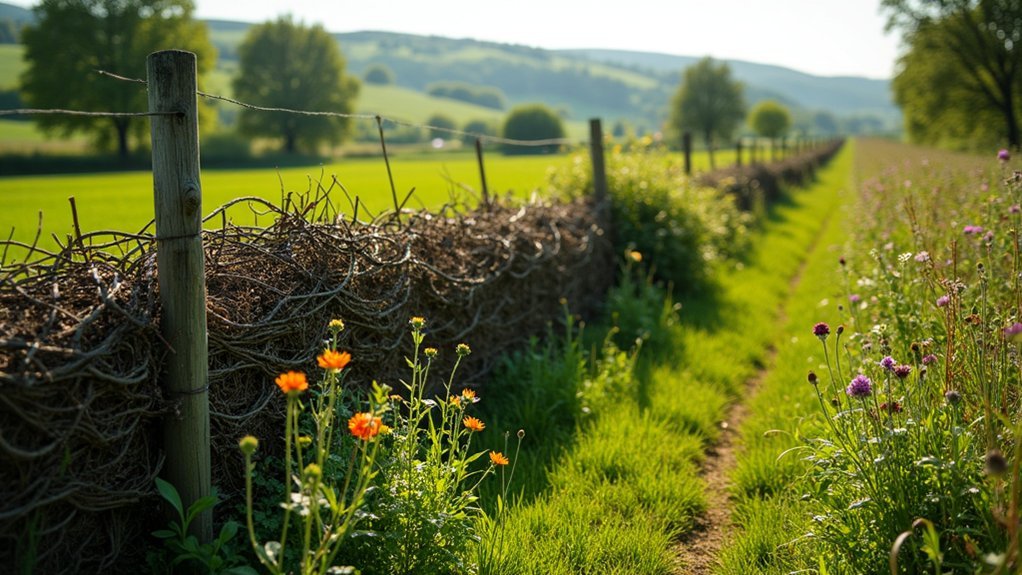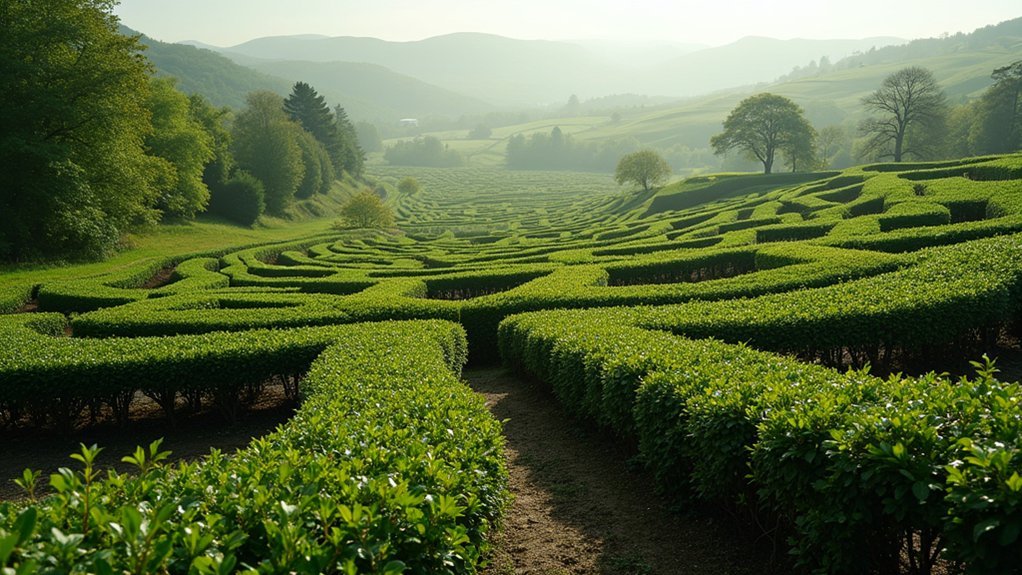Welsh hedge laying endures through centuries because it brilliantly combines practicality with ecological benefits. You’ll find this ancient craft provides cost-effective livestock management while creating robust wildlife corridors that boost biodiversity. Each properly maintained hedgerow sequesters carbon, prevents soil erosion, and connects fragmented habitats. Beyond its environmental value, this living heritage preserves cultural identity and rural craftsmanship that connects communities to their past. Discover how this sustainable boundary solution continues to shape the Welsh countryside.
The Ancient Roots of Welsh Hedge Laying

While modern fencing solutions come and go, Welsh hedge laying has stood the test of time, with origins stretching back to ancient agricultural practices.
If you look at written records from as early as 816 AD, you’ll find evidence of living boundaries crisscrossing the Welsh countryside, showcasing this traditional skill’s remarkable longevity.
The Norman period accelerated hedge development as land clearing expanded, while the 16th century Enclosure Acts cemented distinct regional styles across Wales.
The characteristic stake and pleach technique wasn’t merely decorative—it served critical functions in livestock management and property delineation.
The ancient Welsh stake and pleach method combined artistry with practicality—an ingenious solution for both farm function and field boundaries.
What’s particularly remarkable about Welsh hedge laying is how it balances practical function with environmental benefit, creating habitats that support biodiversity while preserving cultural heritage that spans more than a millennium.
Traditional Tools and Techniques of the Welsh Border Style
You’ll need a sharp billhook, hazel stakes, and flexible binders before starting any Welsh Border hedge laying work.
First, drive your stakes firmly into the ground at regular intervals, creating the framework that will support your pleachers (the partially-cut and bent stems).
The proper sequence matters tremendously—establishing your stakes before cutting and laying the pleachers guarantees the hedge maintains its distinctive structure and stability throughout the process.
Billhooks and Bindings
Craftsmen of the Welsh borders have relied on specialized tools and techniques for centuries to create their distinctive hedgerows. At the heart of hedge laying is the billhook—a curved blade designed specifically for cutting stems at precise angles before bending them into pleachers that form the hedge’s living structure.
When you’re learning this ancient craft, you’ll master these three essential techniques:
- Using billhooks to make angled cuts that allow stems to bend without breaking
- Positioning pleachers at consistent angles along the hedgerow’s length
- Securing the laid stems with bindings made from flexible willow or hazel
Stakes driven into the ground provide vital support for your pleachers, while properly applied bindings hold everything together.
This time-tested combination guarantees your living hedge continues to grow while maintaining its structural integrity for decades to come.
Stakes Before Pleachers
Three vital elements define the authentic Welsh Border hedge laying style, with proper staking standing as the foundation of the entire process. You’ll need to position your stakes before working with pleachers to guarantee the hedge maintains its structural integrity during the vital September-to-April laying season.
| Stake Material | Advantages | Key Function |
|---|---|---|
| Hazel | Flexible & strong | Supports weight of pleachers |
| Local wood | Sustainability | Reduces environmental impact |
| Split stakes | Greater surface area | Improves binding capability |
| Seasoned wood | Durability | Extends hedge lifespan |
When properly implemented, these stakes support pleachers that are cut at specific angles and bent in the same direction. This technique guarantees your hedgerow continues its natural growth while maintaining the distinctive Welsh Border appearance, creating a living barrier that serves both functional and ecological purposes.
Ecological Importance in the Welsh Countryside

The dense lattice of carefully laid Welsh hedgerows serves as more than just field boundaries; they’re thriving ecosystems crucial to the nation’s environmental health.
When you walk alongside these living structures, you’re witnessing centuries of ecological engineering that enhances biodiversity across the countryside.
These ancient hedge systems provide three essential ecological functions:
- Create diverse habitats supporting birds, insects, and mammals that rely on their shelter and food sources
- Improve soil quality and water retention, naturally mitigating flood risks on your land
- Form important wildlife corridors connecting fragmented habitats across the landscape
The ecological significance of these structures is so profound that government legislation now protects them, recognizing that hedge restoration isn’t just preserving tradition—it’s safeguarding irreplaceable habitats for generations to come.
Seasonal Rhythms and Optimal Timing
Timing dictates success in Welsh hedge laying, with practitioners adhering to a strict seasonal calendar that spans from September through April.
You’ll find hedgelayers working during these colder months when plant growth slows dramatically, making stems and branches more pliable and easier to manipulate without causing undue stress.
The hedgelaying season deliberately avoids spring and summer when birds nest and plants actively grow.
By working during autumn and early winter, you’re capitalizing on the natural dormancy of vegetation, which encourages robust new growth once spring arrives.
This ideal timing also aligns with traditional farming cycles, allowing hedgerows to establish themselves before the growing season begins.
These seasonal rhythms aren’t merely tradition—they’re essential practices ensuring the craft’s sustainability through centuries.
Regional Variations Across Welsh Counties

While seasonality governs when Welsh hedge laying occurs, geography shapes how it’s practiced throughout the country. The stake and pleach style you’ll encounter across Wales reflects regional variations developed over centuries to address specific agricultural needs and topography.
Traveling through Welsh counties, you’ll notice distinct approaches:
- Brecon’s double brush method – Creates exceptionally dense barriers ideal for sheep containment while supporting local biodiversity.
- Montgomery’s unique weaving techniques – Utilizes locally available materials, showcasing traditional skills passed down through generations.
- Coastal areas’ wind-resistant designs – Features lower, more tightly woven structures to withstand harsh maritime conditions.
These differences aren’t merely aesthetic—they represent centuries of practical knowledge adapted to local conditions.
Despite modern farming changes, these regional techniques continue to define rural Welsh landscapes and preserve cultural heritage through living boundaries.
The Cultural Heritage of Rural Craftsmanship
Embedded within Wales’ cultural identity, hedge laying represents far more than a practical farm skill—it embodies the living heritage of rural craftsmanship that connects past generations with present communities.
The distinctive stake and pleach style you’ll observe across Welsh countryside isn’t just functional; it’s a proof of centuries of agricultural heritage preserved through hands-on knowledge transmission.
When you witness a hedge layer at work, you’re seeing traditions that once bound rural communities together, where payment in cider sealed agreements and affirmed social bonds.
This craft’s value extends beyond aesthetics—each meticulously laid hedge creates essential biodiversity habitats, demonstrating how traditional craftsmanship inherently embraced environmental stewardship long before it became fashionable.
Today’s renewed interest in these techniques guarantees this cultural cornerstone continues to thrive in modern Wales.
Modern Conservation Efforts and Sustainability

You’ll find traditional hedge laying skills experiencing a renaissance through community workshops that preserve rural craftsmanship while serving conservation goals.
These living boundaries now receive protection through government legislation as essential wildlife corridors connecting fragmented habitats across Wales’s changing landscape.
Beyond their cultural significance, well-maintained hedgerows offer notable carbon capture benefits, sequestering CO2 in their woody growth and protecting soil carbon stores in adjacent fields.
Traditional Skills Revival
Despite centuries of agricultural modernization, the ancient craft of Welsh hedge laying has witnessed a remarkable revival in recent years.
You’ll find conservation efforts now actively supporting these traditional skills, recognizing their importance for both ecological health and cultural heritage.
Community workshops across Wales are reconnecting people with hedgelaying techniques, ensuring this knowledge passes to future generations.
Government backing and social media exposure have accelerated this revival, creating a new audience for these ancient practices.
This resurgence offers:
- Economic incentives for landowners adopting sustainable management
- Training opportunities for those wanting to learn the craft
- Enhanced biodiversity through properly maintained hedgerows
Wildlife Corridor Protection
While modern agriculture often fragments natural landscapes, Welsh hedge laying serves as an important conservation tool by creating robust wildlife corridors across the countryside.
You’ll find these living boundaries support up to 50% more species than poorly maintained hedgerows, providing essential habitats for birds, insects, and mammals.
Recent conservation efforts have revitalized traditional hedgelaying practices throughout Wales, recognizing their significance in connecting isolated habitats.
By maintaining these dense structures, you’re helping wildlife move safely between areas, enhancing genetic diversity and overall biodiversity.
The government now offers financial incentives for landowners who preserve and plant hedgerows, acknowledging their role in habitat quality improvement and landscape resilience.
These initiatives blend centuries-old techniques with modern sustainability goals, ensuring Welsh hedgerows continue their critical ecological function for generations to come.
Carbon Capture Benefits
Beyond their wildlife benefits, traditional Welsh hedgerows serve as remarkable carbon sinks in our modern climate crisis.
When you practice hedgelaying techniques, you’re actively contributing to climate action through sustainable management that enhances both biodiversity and soil health.
The carbon capture potential of these living boundaries is impressive:
- Each hedgerow kilometer sequesters approximately 9.6 tonnes of carbon throughout its lifetime.
- Properly maintained hedgerows store 1.1-2.6 tonnes of carbon per hectare annually.
- Traditional management practices greatly reduce greenhouse gas emissions by promoting healthier soil ecosystems.
Economic Value in Contemporary Land Management

In an era of rising agricultural costs and environmental challenges, Welsh hedge laying stands out as a remarkably cost-effective boundary solution.
You’ll find it reduces expensive fencing costs while simultaneously improving your livestock management capabilities.
By incorporating hedge laying into your farming practices, you’re investing in sustainable land use that pays dividends through potential conservation program incentives.
These living boundaries support habitat creation and biodiversity while minimizing long-term expenses tied to pest control and erosion prevention.
The traditional skills preserved through hedge laying contribute beyond your farm’s boundaries—they attract tourism and foster community engagement that bolsters local economies.
Your well-maintained hedgerows provide essential weather protection for crops and livestock, enhancing farm productivity and profitability in ways synthetic alternatives simply can’t match.
Frequently Asked Questions
What Is the History of Hedge Laying?
Hedge laying dates back to ancient times, first noted in Caesar’s writings. You’ll find it flourished in 16th century Britain after Enclosure Acts, when you’d need to contain livestock and mark property boundaries.
How Long Does a Laid Hedge Last?
Your laid hedge will last 10-15 years before needing re-laying. With annual trimming, you’ll maintain its structure, but after about 20 years, you’ll need to completely renew it to guarantee continued effectiveness.
What Is the Point of Hedge Laying?
You’re creating sustainable, living fences that protect livestock while boosting biodiversity. You’ll rejuvenate hedgerows, prevent erosion, preserve traditional craftsmanship, and establish natural windbreaks that enhance both agricultural functionality and landscape beauty.
What Is the Welsh Border Style of Hedge Laying?
You’ll find the Welsh border style utilizes stakes and pleachers, with stems cut at angles and bent to one side. It’s characterized by weaving branches through cut stems, creating a durable livestock barrier with local materials.
In Summary
You’re witnessing a living tradition that connects you to centuries of Welsh rural life. Whether you’re a landowner, conservationist, or simply appreciate traditional crafts, Welsh hedge laying offers sustainable solutions while preserving biodiversity. As you’ve seen, these living boundaries don’t just divide land—they unite past and present, nurturing wildlife and cultural identity for generations to come.





Leave a Reply